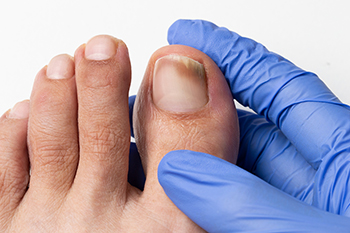Blog
 The importance of practicing everyday foot care is vital in maintaining the health and cleanliness of your feet. There are a variety of methods that can be implemented which can accomplish this. These can consist of washing, drying, and exfoliating the feet daily, followed by applying a good moisturizer. Additionally, it is beneficial to wear shoes that fit correctly. A painful foot condition that is known as ingrown toenails may be prevented when the toenails are properly trimmed. The feet can feel better when shoes and socks are removed for a portion of the day, as this allows air to circulate around them. For more information about how to practice daily foot hygiene habits, please schedule a consultation with a podiatrist.
The importance of practicing everyday foot care is vital in maintaining the health and cleanliness of your feet. There are a variety of methods that can be implemented which can accomplish this. These can consist of washing, drying, and exfoliating the feet daily, followed by applying a good moisturizer. Additionally, it is beneficial to wear shoes that fit correctly. A painful foot condition that is known as ingrown toenails may be prevented when the toenails are properly trimmed. The feet can feel better when shoes and socks are removed for a portion of the day, as this allows air to circulate around them. For more information about how to practice daily foot hygiene habits, please schedule a consultation with a podiatrist.
Everyday foot care is very important to prevent infection and other foot ailments. If you need your feet checked, contact Akena Wannamaker, DPM from ASW Foot and Ankle. Our doctor can provide the care you need to keep you pain-free and on your feet.
Everyday Foot Care
Often, people take care of their bodies, face and hair more so than they do for their feet. But the feet are a very important aspect of our bodies, and one that we should pay more attention to. Without our feet, we would not be able to perform most daily tasks.
It is best to check your feet regularly to make sure there are no new bruises or cuts that you may not have noticed before. For dry feet, moisturizer can easily be a remedy and can be applied as often as necessary to the affected areas. Wearing shoes that fit well can also help you maintain good foot health, as well as making it easier to walk and do daily activities without the stress or pain of ill-fitting shoes, high heels, or even flip flops. Wearing clean socks with closed shoes is important to ensure that sweat and bacteria do not accumulate within the shoe. Clean socks help to prevent Athlete’s foot, fungi problems, bad odors, and can absorb sweat.
If you have any questions, please feel free to contact our office located in Richmond, VA . We offer the newest diagnostic and treatment technologies for all your foot care needs.
 Running is a well-known sport that is loved by many people. However, without the proper knowledge of technique and equipment, many people can suffer running injuries. To avoid these types of injuries, it’s beneficial to gain knowledge on specific prevention tips you can practice while performing the sport. Strengthening your body is an important step in this process. Activation exercises can be useful to look into and perform before you go on a run, that way your body is prepared for physical activity. Increasing the intensity of your runs must be done gradually or your body will react negatively. Another factor in injury prevention is proper footwear. Your shoes should fit comfortably and also offer the necessary support features for the type of running you enjoy. For more information on how to prevent running injuries, please consult with a podiatrist for professional advice and care.
Running is a well-known sport that is loved by many people. However, without the proper knowledge of technique and equipment, many people can suffer running injuries. To avoid these types of injuries, it’s beneficial to gain knowledge on specific prevention tips you can practice while performing the sport. Strengthening your body is an important step in this process. Activation exercises can be useful to look into and perform before you go on a run, that way your body is prepared for physical activity. Increasing the intensity of your runs must be done gradually or your body will react negatively. Another factor in injury prevention is proper footwear. Your shoes should fit comfortably and also offer the necessary support features for the type of running you enjoy. For more information on how to prevent running injuries, please consult with a podiatrist for professional advice and care.
Exercising your feet regularly with the proper foot wear is a great way to prevent injuries. If you have any concerns about your feet, contact Akena Wannamaker, DPM of ASW Foot and Ankle. Our doctor will treat your foot and ankle needs.
How to Prevent Running Injuries
Many common running injuries are caused by overuse and overtraining. When the back of the kneecap starts wearing out and starts causing pain in your knee, this is commonly referred to as runner’s knee. Runner’s knee is a decrease in strength in your quadriceps and can occur if you’re not wearing properly fitted or supporting shoes. To prevent runner’s knee, focusing on hip strengthening is a good idea, as well as strengthening your quads to keep the kneecaps aligned.
What Are Some Causes of Running Injuries?
- One cause of a common running injury is called iliotibial band syndrome.
- Plantar fasciitis is also another common injury.
- Stress fractures can occur from overtraining, lack of calcium, or even your running style.
Best Ways to Prevent Running Injuries
- Wear footwear that fits properly and suits your running needs.
- Running shoes are the only protective gear that runners have to safeguard them from injury.
- Make a training schedule. Adding strengthening exercises as well as regular stretching can help keep you strong and limber and can lessen the possibility of injuries.
- Stretching keeps muscles limber; this will help you gain better flexibility.
If you have any questions, please feel free to contact our office located in Richmond, VA . We offer the newest diagnostic and treatment technologies for all your foot care needs.

Toenail fungus can cause the toenails to become brittle and yellow. They can gradually harden and become thicker, causing difficulty in having them properly trimmed. This unsightly foot condition is caused by a fungal infection, and is considered to be contagious. This type of fungus lives and thrives in warm and moist environments, consisting of shower room floors, public swimming pools, and similar areas. The fungus can enter the body through tiny cracks in the skin, and it is beneficial to wear appropriate shoes while in these types of areas. A diagnosis is performed by extracting a small sample of the nail. After confirmation is received, treatment can begin. There are various methods that can accomplish this, and it is strongly suggested a podiatrist is contacted as quickly as possible who can prescribe proper medication.
For more information about treatment, contact Akena Wannamaker, DPM of ASW Foot and Ankle. Our doctor can provide the care you need to keep you pain-free and on your feet.
Toenail Fungus Treatment
Toenail fungus is a condition that affects many people and can be especially hard to get rid of. Fortunately, there are several methods to go about treating and avoiding it.
Antifungals & Deterrence
Oral antifungal medicine has been shown to be effective in many cases. It is important to consult with a podiatrist to determine the proper regiment for you, or potentially explore other options.
Applying foot powder on the feet and shoes helps keep the feet free of moisture and sweat.
Sandals or open toed shoes – Wearing these will allow air movement and help keep feet dry. They also expose your feet to light, which fungus cannot tolerate. Socks with moisture wicking material also help as well.
If you have any questions please contact our office located in Richmond, VA . We offer the newest diagnostic and treatment technologies for all your foot and ankle needs.

